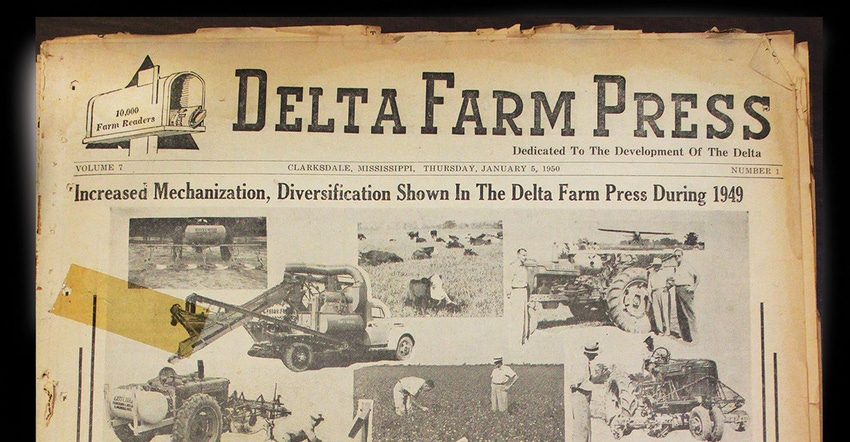
Thumbing through back issues of Delta Farm Press offers a history lesson in the evolution of agriculture and a reminder that despite innovations, technology and mechanization, some problems never go away.
The April 16, 1959, issue featured a story about wilt. “Wilt takes big bite out of cotton crop,” the headline read. More than 50 years later, wilt is still chewing up cotton plants.
That same issue offered an update on the cotton market. Middling, 1-inch cotton was averaging 34.49 cents a pound. Seems like 60 years later the difference should be greater than about 30 cents, considering the huge disparity in production costs.
An April 23, 1959, article indicated Arkansas would plant one-third more cotton than in 1958, pushing planting up to 1.35 million acres. Recent reports indicate Arkansas will plant less than half that in 2018.
The following week offered timely information about boll weevils. The “Boll Weevil and 1959 crop in Louisiana,” story warned farmers that the pest would be back in higher numbers compared to 1958. “A substantially larger number of weevils survived last winter than the previous winter,” the article stated. “Three parishes in Louisiana averaged 2,246 weevils per acre this year compared to 1,480 last year.”
Weevil control
Another article in that same issue offered recommendations to control weevils, including “phosphate insecticides continue to control weevils when applied on a four- to five-day schedule. When you combine chlorinated hydrocarbon insecticides such as toxaphene with DDT the percent kill of boll weevil is better than when you use other insecticides alone.”
Boll weevils were a constant threat to Delta cotton farmers, costing them millions of dollars in yield losses and adding significant production costs. Into the 1970s, 1980s and 1990s, cotton farmers were making scheduled applications of numerous insecticides and still losing hundreds of pounds of cotton per acre to boll weevils.
It would be four decades from those 1959 Delta Farm Press warnings before a concerted effort was mounted to eliminate the pest as an economic factor in Delta cotton production.
Even that effort came with some controversy. A July 28, 2000, issue featured a story about Boll Weevil Eradication funding. “Miss. Eradication short funds,” the headline read. The shortage came from cutbacks in federal support, an issue that continues to bedevil farmers across the Cotton Belt, even with the boll weevil control now relegated to monitoring across the Delta.
The article also noted that the adoption of Bt cotton varieties resulted in fewer insecticide spray applications “and weevil numbers exploded.”
Narrow-row cotton
An article earlier in the month discussed narrow-row cotton. “Ultra-narrow row cotton pays off” featured farmer Kenneth Hood, Gunnison, Miss., who said, “We’ve got to find ways to lower our costs and improve the bottom line.”
That sounds like many articles Delta Farm Press has published in the last few weeks.
We also could have recently seen this Aug. 4, 2000, headline: “Farmers say strengthen safety net.” A panel was calling for improvements in the so called “Freedom to Farm” program that many farmers re-dubbed “Freedom to Fail.”
The battle to get Congress to enact farm policy that protects agriculture from weather and market disasters shows up in almost every issue of Delta Farm Press and almost daily on the Delta Farm Press website. It’s a topic that’s particularly relevant as the current Congress seeks to develop a program that puts cotton back into the farm bill.
Another article that could be published today discussed the benefits of bio-controls. And another story included complaints about the EPA and the Clean Water Act. Almost 20 years later, that issue remains as relevant as it was in 2000.
Advertisements
The advertisements, especially the ones from the 1950s, offer a snapshot of how far mechanization has come in 75 years. For one thing, you see ads for a lot of brands — Case, International Harvester, John Deere, Allis Chalmers, Ford and others, many of whom have merged or disappeared.
Some of those tractors are still around, mostly in restored versions looking as polished as when they rolled off the assembly line. Those 1950s-era tractors bear little resemblance to the large, powerful units on modern farms. Operators were exposed to the element: heat, cold and dust. Auto-steering was not an available option, neither was air conditioning nor on-board computers.
Many of the chemical and seed companies prevalent in the early days of Delta Farm Press have been bought, merged or otherwise displaced. Remember Coker Pedigreed Seed?
A farmer we interviewed for another article in our 75th Anniversary special section (April 20, 2018) noted that Delta Farm Press and agriculture witnessed an evolution similar to changes in manned flight — from the first flight in 1903 through the ability to put a man on the moon in 1968. And farm technology has continued to evolve since then and we can expect technology to “boldly go,” if you’ll excuse the cliché, with better seeds, more precise application of seed, fertilizer and crop protection products as agriculture is called on to feed a rapidly increasing population.
Delta Farm Press will continue to record those innovations and to champion the farmers and ranchers who feed and clothe the world.
About the Author(s)
You May Also Like






